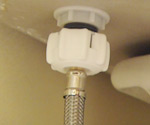Some Easy Ways of Doing a Sponge Bath

![]()
We're taking a look at three very different bathroom renovations, from budget to modest to elaborate, that showcase the range of options available and demonstrate what's involved in tackling a bathroom remodel in your home.
Budget Bathroom Makeover

This small bathroom was overdue for remodeling. While the cultured marble shower was in good condition, the peel and stick vinyl floor, vanity, and toilet all needed updating.
The first step was to remove the vanity, toilet, and vinyl flooring. Once the old tile floor under it has been thoroughly cleaned, porcelain tile were laid directly over it in a diagonal pattern using latex modified thin-set adhesive.
After the baseboard had been installed, the walls and trim were given a fresh coat of paint. The new vanity was then secured in place, and the sink top and faucet attached.
The final touches included installing glass doors on the shower, and replacing the existing toilet with a dual flush model, which can save 6,000 gallons of water per year.

Find out more about this bathroom at Bathroom Makeover.
Modest Bathroom Upgrade

In our second bathroom renovation, we started by removing the cultured marble tub surround, linen cabinet, pedestal sink, and existing tile floor. The remodel also necessitated reworking some of the plumbing and wiring for the new faucets and light fixture.
Next, the walls around the tub were covered with cement backer board and waterproofed. Large 12"x12" tile were applied to the walls, supported by a ledger strip. A horizontal mosaic glass tile band was used to accent the tile on the shower walls, and the same mosaic tile were used on the floor to tie the room together.
Once the wood floor in the adjoining powder room had been patched, a furniture style vanity, with black granite top and white undermounted sink, was installed to give the room a touch of elegance.

Find out more about this bathroom at Bath Basics.
Major Bathroom Renovation

Our last bathroom project included gutting and removing a wall to turn a two-room bathroom into one large room with a walk-in shower, soaking tub, and matching his and hers vanities.
The tile floor and plywood subfloor had to be removed to allow access to the plumbing below, which was in need of repair. Once the plumbing and wiring had been roughed in, a new subfloor and drywall were installed.
To construct the custom shower, a flexible vinyl membrane was placed on the floor, and extended up the walls behind the cement backer board to prevent any leaks. The walls were waterproofed, and a mortar bed troweled out on the floor and carefully sloped toward the drain to prevent puddles. The wall and floor tile were then laid and grout applied.

Find out more about this bathroom at Bath Finale.
Other Tips from This Episode

Simple Solutions with Joe Truini:
Cutting Cement Backer Board
A jigsaw fitted with a metal cutting blade can be used to cut holes in cement backer board. Drill a hole or plunge cut the blade into the backer board, then complete the cut. Always wear dust and eye protection when cutting cement backer board. (Watch Video)

Best New Products with Jodi Marks:
Click-Seal Toilet Connector
The Fluidmaster Click-Seal toilet supply line clicks to let you know when the correct tightness has been reached to prevent cracking the nut by over tightening. The supply line is made of durable stainless steel tubing and is available at The Home Depot in different lengths. (Watch Video)

Ask Danny Lipford:
Choosing Bathroom Vanity Materials
Since bathrooms have higher humidity levels than other rooms in the house, the materials used to construct the vanity need to hold up under high moisture conditions. For this reason avoid buying a vanity made from particle board, which can deteriorate over time. While MDF (medium density fiberboard) holds up okay, cabinet grade plywood and solid wood are the best choices. (Watch Video)
Source: https://todayshomeowner.com/television/baths-baths-and-more-baths/
0 Response to "Some Easy Ways of Doing a Sponge Bath"
Post a Comment